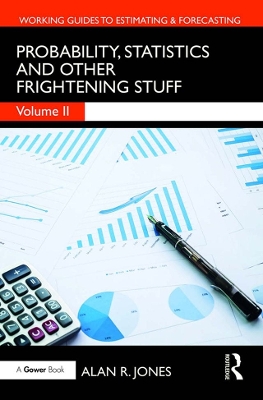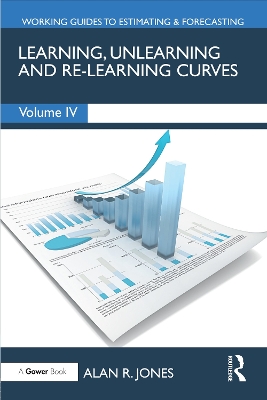Probability, Statistics and Other Frightening Stuff
 portes grátis
portes grátis
Probability, Statistics and Other Frightening Stuff
Jones, Alan
Taylor & Francis Ltd
01/2025
500
Mole
9781032948539
Pré-lançamento - envio 15 a 20 dias após a sua edição
Descrição não disponível.
Volume II Table of Contents, 1 Introduction and Objectives, 1.1 Why write this book? Who might find it useful? Why Five Volumes? 1.1.1 Why write this series? Who might find it useful? 1.1.2 Why Five Volumes? 1.2 Features you'll find in this book and others in this series, 1.2.1 Chapter Context, 1.2.2 The Lighter Side (humour), 1.2.3 Quotations, 1.2.4 Definitions, 1.2.5 Discussions and Explanations with a Mathematical Slant for Formula-philes, 1.2.6 Discussions and Explanations without a Mathematical Slant for Formula -phobes, 1.2.7 Caveat Augur, 1.2.8 Worked Examples, 1.2.9 Useful Microsoft Excel Functions and Facilities, 1.2.10 References to Authoritative Sources, 1.2.11 Chapter Reviews, 1.3 Overview of Chapters in this Volume, 1.4 Elsewhere in the 'Working Guide to Estimating & Forecasting' Series, 1.4.1 Volume I: Principles, Process and Practice of Professional Number Juggling, 1.4.2 Volume II: Probability, Statistics and other Frightening Stuff, 1.4.3 Volume III: Best Fit Lines & Curves, and some Mathe-Magical Transformations, 1.4.4 Volume IV: Learning, Unlearning and Re-Learning Curves, 1.4.5 Volume V: Risk, Opportunity, Uncertainty and Other Random Models, 1.5 Final Thoughts and Musings on this Volume and Series, References, 2 Measures of Central Tendency: Means, Modes, Medians, 2.1 'S' is for Shivers, Statistics and Spin, 2.1.1 Cutting through the Mumbo-Jumbo: What is or are Statistics? 2.1.2 Are there any types of Statistics that are not 'Descriptive'? 2.1.3 Samples, Populations and the Dreaded Statistical Bias, 2.2 Measures of Central Tendency, 2.2.1 What do we mean by 'Mean'? 2.2.2 Can we take the Average of an Average? 2.3 Arithmetic Mean - The Simple Average, 2.3.1 Properties of Arithmetic Means: A Potentially Unachievable Value! 2.3.2 Properties of Arithmetic Means: An Unbiased Representative Value of the Whole, 2.3.3 Why would we not want to use the Arithmetic Mean? 2.3.4 Is an Arithmetic Mean useful where there is an upward or downward trend? 2.3.5 Average of Averages: Can we take the Arithmetic Mean of an Arithmetic Mean? 2.4 Geometric Mean, 2.4.1 Basic Rules and Properties of a Geometric Mean, 2.4.2 When might we want to use a Geometric Mean? 2.4.3 Finding a steady state rate of growth or decay with a Geometric Mean, 2.4.4 Using a Geometric Mean as a Cross-Driver Comparator, 2.4.5 Using a Geometric Mean with Certain Non-Linear Regressions, 2.4.6 Average of Averages: Can we take the Geometric Mean of a Geometric Mean? 2.5 Harmonic Mean, 2.5.1 Surely Estimators would never use the Harmonic Mean? 2.5.2 Cases where the Harmonic Mean and the Arithmetic Mean are both inappropriate, 2.5.3 Average of Averages: Can we take the Harmonic Mean of a Harmonic Mean?, 2.6 Quadratic Mean: Root Mean Square, 2.6.1 When would we ever use a Quadratic Mean? 2.7 Comparison of Arithmetic, Geometric, Harmonic and Quadratic Means, 2.8 Mode, 2.8.1 When would we use the Mode instead of the Arithmetic Mean? 2.8.2 What does it mean if we observe more than one Mode? 2.8.3 What if we have two modes that occur at adjacent values? 2.8.4 Approximating the Theoretical Mode when there is no Real Observable Mode! 2.9 Median, 2.9.1 Primary Use of the Median, 2.9.2 Finding the Median, 2.10 Choosing a Representative Value: The 5-Ms, 2.10.1 Some Properties of the 5-Ms, 2.11 Chapter Review, References, 3 Measures of Dispersion and Shape, 3.1 Measures of Dispersion or Scatter around a Central Value, 3.2 Minimum, Maximum and Range, 3.3 Absolute Deviations, 3.3.1 Mean or Average Absolute Deviation (AAD), 3.3.2 Median Absolute Deviation (MAD), 3.3.3 Is there a Mode Absolute Deviation? 3.3.4 When would we use an Absolute Deviation? 3.4 Variance and Standard Deviation, 3.4.1 Variance and Standard Deviation - Compensating for Small Samples, 3.4.2 Coefficient of Variation, 3.4.3 The Range Rule - Is it Myth or Magic? 3.5 Comparison of Deviation-Based Measures of Dispersion, 3.6 Confidence Levels, Limits and Intervals, 3.6.1 Open and Closed Confidence Level Ranges, 3.7 Quantiles: Quartiles, Quintiles, Deciles and Percentiles, 3.7.1 A few more words about Quartiles, 3.7.2 A few thoughts about Quintiles, 3.7.3 And a few words about Deciles, 3.7.4 Finally, a few words about Percentiles, 3.8 Other Measures of Shape: Skewness and Peakedness, 3.8.1 Measures of Skewness, 3.8.2 Measures of Peakedness or Flatness - Kurtosis, 3.9 Chapter Review, References, 4 Probability Distributions, 4.1 Probability, 4.1.1 Discrete Distributions, 4.1.2 Continuous Distributions, 4.1.3 Bounding Distributions, 4.2 Normal Distributions, 4.2.1 What is a Normal Distribution? 4.2.2 Key Properties of a Normal Distribution, 4.2.3 Where is the Normal Distribution observed? When can, or should, it be used? 4.2.4 Probability Density Function and Cumulative Distribution Function, 4.2.5 Key Stats and Facts about the Normal Distribution, 4.3 Uniform Distributions, 4.3.1 Discrete Uniform Distributions, 4.3.2 Continuous Uniform Distributions, 4.3.3 Key Properties of a Uniform Distribution, 4.3.4 Where is the Uniform Distribution observed? When can, or should, it be used? 4.3.5 Key Stats and Facts about the Uniform Distribution, 4.4 Binomial and Bernoulli Distributions, 4.4.1 What is a Binomial Distribution? 4.4.2 What is a Bernoulli Distribution? 4.4.3 Probability Mass Function and Cumulative Distribution Function, 4.4.4 Key Properties of a Binomial Distribution, 4.4.5 Where is the Binomial Distribution observed? When can, or should, it be used? 4.4.6 Key Stats and Facts about the Binomial Distribution, 4.5 Beta Distributions, 4.4.1 What is a Beta Distribution? 4.4.2 Probability Density Function and Cumulative Distribution Function, 4.4.3 Key Properties of a Beta Distribution, 4.4.4 PERT-Beta or Project Beta Distributions, 4.4.5 Where is the Beta Distribution observed? When can, or should, it be used? 4.4.6 Key Stats and Facts about the Beta Distribution, 4.6 Triangular Distributions, 4.6.1 What is a Triangular Distribution? 4.6.2 Probability Density Function and Cumulative Distribution Function, 4.6.3 Key Properties of a Triangular Distribution, 4.6.4 Where is the Triangular Distribution observed? When can, or should, it be used? 4.6.5 Key Stats and Facts about the Triangular Distribution, 4.7 Lognormal Distributions, 4.7.1 What is a Lognormal Distribution? 4.7.2 Probability Density Function and Cumulative Distribution Function, 4.7.3 Key Properties of a Lognormal Distribution, 4.7.4 Where is the Lognormal Distribution observed? When can, or should, it be used? 4.7.5 Key Stats and Facts about the Lognormal Distribution, 4.8 Weibull Distributions, 4.8.1 What is a Weibull Distribution? 4.8.2 Probability Density Function and Cumulative Distribution Function, 4.8.3 Key Properties of a Weibull Distribution, 4.8.4 Where is the Weibull Distribution observed? When can, or should, it be used? 4.8.5 Key Stats and Facts about the Weibull Distribution, 4.9 Poisson Distributions, 4.9.1 What is a Poisson Distribution? 4.9.2 Probability Mass Function and Cumulative Distribution Function, 4.9.3 Key Properties of a Poisson Distribution, 4.9.4 Where is the Poisson Distribution observed? When can, or should, it be used? 4.9.5 Key Stats and Facts about the Poisson Distribution, 4.10 Gamma and Chi-Squared Distributions, 4.10.1 What is a Gamma Distribution? 4.10.2 What is a Chi-Squared Distribution? 4.10.3 Probability Density Function and Cumulative Distribution Function, 4.10.4 Key Properties of Gamma and Chi-Squared Distributions, 4.10.5 Where are the Gamma and Chi-Squared Distributions used? 4.10.6 Key Stats and Facts about the Gamma and Chi-Squared Distributions,4.11 Exponential Distributions, 4.11.1 What is an Exponential Distribution? 4.11.2 Probability Density Function and Cumulative Distribution Function, 4.11.3 Key Properties of an Exponential Distribution, 4.11.4 Where is the Exponential Distribution observed? When can, or should, it be used? 4.11.5 Key Stats and Facts about the Exponential Distribution, 4.12 Pareto Distributions, 4.12.1 What is a Pareto Distribution? 4.12.2 Probability Density Function and Cumulative Distribution Function, 4.12.3 The Pareto Principle: How does it fit in with the Pareto Distribution? 4.12.4 Key Properties of a Pareto Distribution, 4.12.5 Where is the Pareto Distribution observed? When can, or should, it be used? 4.12.6 Key Stats and Facts about the Pareto Distribution, 4.13 Choosing an Appropriate Distribution, 4.14 Chapter Review, References, 5 Measures of Linearity, Dependence and Correlation, 5.1 Covariance, 5.2 Linear Correlation or Measures of Linear Dependence, 5.2.1 Pearson's Correlation Coefficient, 5.2.2 Pearson's Correlation Coefficient - Key Properties and Limitations, 5.2.3 Correlation is not Causation, 5.2.4 Partial Correlation: Time for some Correlation Chicken, 5.2.5 Coefficient of Determination, 5.3 Rank Correlation, 5.3.1 Spearman's Rank Correlation Coefficient, 5.3.2 If Spearman's Rank Correlation is so much trouble, why bother? 5.3.3 Interpreting Spearman's Rank Correlation Coefficient, 5.3.4 Kendall's Tau Rank Correlation Coefficient, 5.3.5If Kendall's Tau Rank Correlation is so much trouble, why bother? 5.4 Correlation: What if you want to 'Push' it not 'Pull' it? 5.4.1 The Pushy Pythagorean Technique or Restricting the Scatter around a Straight Line, 5.4.2 'Controlling Partner' Technique, 5.4.3 Equivalence of the Pushy Pythagorean and Controlling Partner Techniques, 5.4.4 'Equal Partners' Technique, 5.4.5 Copulas, 5.5 Chapter Review, References, 6 Tails of the Unexpected (1): Hypothesis Testing, 6.1 Hypothesis Testing, 6.1.1 Tails of the Unexpected, 6.2 Z-Scores and Z-Tests, 6.2.1 Standard Error, 6.2.2 Example: Z-Testing the Mean Value of a Normal Distribution, 6.2.3 Example: Z-Testing the Median Value of a Beta Distribution, 6.3 Student's t-Distribution and t-Tests, 6.3.1 Student's t-Distribution, 6.3.2 t-Tests, 6.3.3 Performing a t-Test in Microsoft Excel on a Single Sample, 6.3.4 Performing a t-Test in Microsoft Excel to Compare Two Samples, 6.4 Mann-Whitney U-Tests, 6.5 Chi-Squared Tests or 2-Tests, 6.5.1 Chi-Squared Distribution Revisited, 6.5.2 Chi-Squared Test, 6.6 F-Distribution and F-Tests, 6.6.1 F-Distribution, 6.6.2 F-Test, 6.6.3 Primary Use of the F-Distribution, 6.7 Checking for Normality, 6.7.1 Q-Q Plots, 6.7.2 Using a Chi-Square Test for Normality, 6.7.3 Using the Jarque-Bera Test for Normality, 6.8 Chapter Review, References, 7 Tails of the Unexpected (2): Outing the Outliers, 7.1 Outing the Outliers: Detecting and Dealing with Outliers, 7.1.1 Mitigation of Type I and Type II Outlier Errors, 7.2 Tukey Fences, 7.2.1 Tukey Slimline Fences - For Larger Samples and Less Tolerance of Outliers? 7.3 Chauvenet's Criterion, 7.3.1 Variation on Chauvenet's Criterion for Small Sample Sizes (SSS), 7.3.2 Taking a Q-Q Perspective on Chauvenet's Criterion for Small Sample Sizes (SSS), 7.4 Peirce's Criterion, 7.5 Iglewicz and Hoaglin's MAD Technique, 7.6 Grubbs' Test, 7.7 Generalised Extreme Studentised Deviate (GESD), 7.8 Dixon's Q-Test, 7.9 Doing the JB Swing - Using Skewness and Excess Kurtosis to identify Outliers, 7.10 Outlier Tests - A Comparison, 7.11 Chapter Review, References, Glossary of Estimating Terms
Este título pertence ao(s) assunto(s) indicados(s). Para ver outros títulos clique no assunto desejado.
General Beta Distribution;Central Tendency;Excess Kurtosis;Means;Pearson's Linear Correlation;Modes;Beta Distribution;Median;CDF;Dispersion;Mad;Variance;Chauvenet's Criterion;Standard Deviation;Student's t-Distribution;Absolute Deviation;JB Statistic;Skewness;Chi Squared Distribution;Skewness Coefficient;Probability Distributions;Microsoft Excel Functions;Linear Correlation;Continuous Unimodal Distributions;Rank Correlation;AAD;Hypothesis Testing;Potential Outlier;Outlier Detection;Pareto Minimum;Alan R. Jones;Peirce's Criterion;outliers;Spearman's Rank Correlation;working guide to estimating and forecasting;Pareto Distribution;Normal Copula;Triangular Distribution;Weibull Distribution;Suspect Point;Data Set;Volume Iii
Volume II Table of Contents, 1 Introduction and Objectives, 1.1 Why write this book? Who might find it useful? Why Five Volumes? 1.1.1 Why write this series? Who might find it useful? 1.1.2 Why Five Volumes? 1.2 Features you'll find in this book and others in this series, 1.2.1 Chapter Context, 1.2.2 The Lighter Side (humour), 1.2.3 Quotations, 1.2.4 Definitions, 1.2.5 Discussions and Explanations with a Mathematical Slant for Formula-philes, 1.2.6 Discussions and Explanations without a Mathematical Slant for Formula -phobes, 1.2.7 Caveat Augur, 1.2.8 Worked Examples, 1.2.9 Useful Microsoft Excel Functions and Facilities, 1.2.10 References to Authoritative Sources, 1.2.11 Chapter Reviews, 1.3 Overview of Chapters in this Volume, 1.4 Elsewhere in the 'Working Guide to Estimating & Forecasting' Series, 1.4.1 Volume I: Principles, Process and Practice of Professional Number Juggling, 1.4.2 Volume II: Probability, Statistics and other Frightening Stuff, 1.4.3 Volume III: Best Fit Lines & Curves, and some Mathe-Magical Transformations, 1.4.4 Volume IV: Learning, Unlearning and Re-Learning Curves, 1.4.5 Volume V: Risk, Opportunity, Uncertainty and Other Random Models, 1.5 Final Thoughts and Musings on this Volume and Series, References, 2 Measures of Central Tendency: Means, Modes, Medians, 2.1 'S' is for Shivers, Statistics and Spin, 2.1.1 Cutting through the Mumbo-Jumbo: What is or are Statistics? 2.1.2 Are there any types of Statistics that are not 'Descriptive'? 2.1.3 Samples, Populations and the Dreaded Statistical Bias, 2.2 Measures of Central Tendency, 2.2.1 What do we mean by 'Mean'? 2.2.2 Can we take the Average of an Average? 2.3 Arithmetic Mean - The Simple Average, 2.3.1 Properties of Arithmetic Means: A Potentially Unachievable Value! 2.3.2 Properties of Arithmetic Means: An Unbiased Representative Value of the Whole, 2.3.3 Why would we not want to use the Arithmetic Mean? 2.3.4 Is an Arithmetic Mean useful where there is an upward or downward trend? 2.3.5 Average of Averages: Can we take the Arithmetic Mean of an Arithmetic Mean? 2.4 Geometric Mean, 2.4.1 Basic Rules and Properties of a Geometric Mean, 2.4.2 When might we want to use a Geometric Mean? 2.4.3 Finding a steady state rate of growth or decay with a Geometric Mean, 2.4.4 Using a Geometric Mean as a Cross-Driver Comparator, 2.4.5 Using a Geometric Mean with Certain Non-Linear Regressions, 2.4.6 Average of Averages: Can we take the Geometric Mean of a Geometric Mean? 2.5 Harmonic Mean, 2.5.1 Surely Estimators would never use the Harmonic Mean? 2.5.2 Cases where the Harmonic Mean and the Arithmetic Mean are both inappropriate, 2.5.3 Average of Averages: Can we take the Harmonic Mean of a Harmonic Mean?, 2.6 Quadratic Mean: Root Mean Square, 2.6.1 When would we ever use a Quadratic Mean? 2.7 Comparison of Arithmetic, Geometric, Harmonic and Quadratic Means, 2.8 Mode, 2.8.1 When would we use the Mode instead of the Arithmetic Mean? 2.8.2 What does it mean if we observe more than one Mode? 2.8.3 What if we have two modes that occur at adjacent values? 2.8.4 Approximating the Theoretical Mode when there is no Real Observable Mode! 2.9 Median, 2.9.1 Primary Use of the Median, 2.9.2 Finding the Median, 2.10 Choosing a Representative Value: The 5-Ms, 2.10.1 Some Properties of the 5-Ms, 2.11 Chapter Review, References, 3 Measures of Dispersion and Shape, 3.1 Measures of Dispersion or Scatter around a Central Value, 3.2 Minimum, Maximum and Range, 3.3 Absolute Deviations, 3.3.1 Mean or Average Absolute Deviation (AAD), 3.3.2 Median Absolute Deviation (MAD), 3.3.3 Is there a Mode Absolute Deviation? 3.3.4 When would we use an Absolute Deviation? 3.4 Variance and Standard Deviation, 3.4.1 Variance and Standard Deviation - Compensating for Small Samples, 3.4.2 Coefficient of Variation, 3.4.3 The Range Rule - Is it Myth or Magic? 3.5 Comparison of Deviation-Based Measures of Dispersion, 3.6 Confidence Levels, Limits and Intervals, 3.6.1 Open and Closed Confidence Level Ranges, 3.7 Quantiles: Quartiles, Quintiles, Deciles and Percentiles, 3.7.1 A few more words about Quartiles, 3.7.2 A few thoughts about Quintiles, 3.7.3 And a few words about Deciles, 3.7.4 Finally, a few words about Percentiles, 3.8 Other Measures of Shape: Skewness and Peakedness, 3.8.1 Measures of Skewness, 3.8.2 Measures of Peakedness or Flatness - Kurtosis, 3.9 Chapter Review, References, 4 Probability Distributions, 4.1 Probability, 4.1.1 Discrete Distributions, 4.1.2 Continuous Distributions, 4.1.3 Bounding Distributions, 4.2 Normal Distributions, 4.2.1 What is a Normal Distribution? 4.2.2 Key Properties of a Normal Distribution, 4.2.3 Where is the Normal Distribution observed? When can, or should, it be used? 4.2.4 Probability Density Function and Cumulative Distribution Function, 4.2.5 Key Stats and Facts about the Normal Distribution, 4.3 Uniform Distributions, 4.3.1 Discrete Uniform Distributions, 4.3.2 Continuous Uniform Distributions, 4.3.3 Key Properties of a Uniform Distribution, 4.3.4 Where is the Uniform Distribution observed? When can, or should, it be used? 4.3.5 Key Stats and Facts about the Uniform Distribution, 4.4 Binomial and Bernoulli Distributions, 4.4.1 What is a Binomial Distribution? 4.4.2 What is a Bernoulli Distribution? 4.4.3 Probability Mass Function and Cumulative Distribution Function, 4.4.4 Key Properties of a Binomial Distribution, 4.4.5 Where is the Binomial Distribution observed? When can, or should, it be used? 4.4.6 Key Stats and Facts about the Binomial Distribution, 4.5 Beta Distributions, 4.4.1 What is a Beta Distribution? 4.4.2 Probability Density Function and Cumulative Distribution Function, 4.4.3 Key Properties of a Beta Distribution, 4.4.4 PERT-Beta or Project Beta Distributions, 4.4.5 Where is the Beta Distribution observed? When can, or should, it be used? 4.4.6 Key Stats and Facts about the Beta Distribution, 4.6 Triangular Distributions, 4.6.1 What is a Triangular Distribution? 4.6.2 Probability Density Function and Cumulative Distribution Function, 4.6.3 Key Properties of a Triangular Distribution, 4.6.4 Where is the Triangular Distribution observed? When can, or should, it be used? 4.6.5 Key Stats and Facts about the Triangular Distribution, 4.7 Lognormal Distributions, 4.7.1 What is a Lognormal Distribution? 4.7.2 Probability Density Function and Cumulative Distribution Function, 4.7.3 Key Properties of a Lognormal Distribution, 4.7.4 Where is the Lognormal Distribution observed? When can, or should, it be used? 4.7.5 Key Stats and Facts about the Lognormal Distribution, 4.8 Weibull Distributions, 4.8.1 What is a Weibull Distribution? 4.8.2 Probability Density Function and Cumulative Distribution Function, 4.8.3 Key Properties of a Weibull Distribution, 4.8.4 Where is the Weibull Distribution observed? When can, or should, it be used? 4.8.5 Key Stats and Facts about the Weibull Distribution, 4.9 Poisson Distributions, 4.9.1 What is a Poisson Distribution? 4.9.2 Probability Mass Function and Cumulative Distribution Function, 4.9.3 Key Properties of a Poisson Distribution, 4.9.4 Where is the Poisson Distribution observed? When can, or should, it be used? 4.9.5 Key Stats and Facts about the Poisson Distribution, 4.10 Gamma and Chi-Squared Distributions, 4.10.1 What is a Gamma Distribution? 4.10.2 What is a Chi-Squared Distribution? 4.10.3 Probability Density Function and Cumulative Distribution Function, 4.10.4 Key Properties of Gamma and Chi-Squared Distributions, 4.10.5 Where are the Gamma and Chi-Squared Distributions used? 4.10.6 Key Stats and Facts about the Gamma and Chi-Squared Distributions,4.11 Exponential Distributions, 4.11.1 What is an Exponential Distribution? 4.11.2 Probability Density Function and Cumulative Distribution Function, 4.11.3 Key Properties of an Exponential Distribution, 4.11.4 Where is the Exponential Distribution observed? When can, or should, it be used? 4.11.5 Key Stats and Facts about the Exponential Distribution, 4.12 Pareto Distributions, 4.12.1 What is a Pareto Distribution? 4.12.2 Probability Density Function and Cumulative Distribution Function, 4.12.3 The Pareto Principle: How does it fit in with the Pareto Distribution? 4.12.4 Key Properties of a Pareto Distribution, 4.12.5 Where is the Pareto Distribution observed? When can, or should, it be used? 4.12.6 Key Stats and Facts about the Pareto Distribution, 4.13 Choosing an Appropriate Distribution, 4.14 Chapter Review, References, 5 Measures of Linearity, Dependence and Correlation, 5.1 Covariance, 5.2 Linear Correlation or Measures of Linear Dependence, 5.2.1 Pearson's Correlation Coefficient, 5.2.2 Pearson's Correlation Coefficient - Key Properties and Limitations, 5.2.3 Correlation is not Causation, 5.2.4 Partial Correlation: Time for some Correlation Chicken, 5.2.5 Coefficient of Determination, 5.3 Rank Correlation, 5.3.1 Spearman's Rank Correlation Coefficient, 5.3.2 If Spearman's Rank Correlation is so much trouble, why bother? 5.3.3 Interpreting Spearman's Rank Correlation Coefficient, 5.3.4 Kendall's Tau Rank Correlation Coefficient, 5.3.5If Kendall's Tau Rank Correlation is so much trouble, why bother? 5.4 Correlation: What if you want to 'Push' it not 'Pull' it? 5.4.1 The Pushy Pythagorean Technique or Restricting the Scatter around a Straight Line, 5.4.2 'Controlling Partner' Technique, 5.4.3 Equivalence of the Pushy Pythagorean and Controlling Partner Techniques, 5.4.4 'Equal Partners' Technique, 5.4.5 Copulas, 5.5 Chapter Review, References, 6 Tails of the Unexpected (1): Hypothesis Testing, 6.1 Hypothesis Testing, 6.1.1 Tails of the Unexpected, 6.2 Z-Scores and Z-Tests, 6.2.1 Standard Error, 6.2.2 Example: Z-Testing the Mean Value of a Normal Distribution, 6.2.3 Example: Z-Testing the Median Value of a Beta Distribution, 6.3 Student's t-Distribution and t-Tests, 6.3.1 Student's t-Distribution, 6.3.2 t-Tests, 6.3.3 Performing a t-Test in Microsoft Excel on a Single Sample, 6.3.4 Performing a t-Test in Microsoft Excel to Compare Two Samples, 6.4 Mann-Whitney U-Tests, 6.5 Chi-Squared Tests or 2-Tests, 6.5.1 Chi-Squared Distribution Revisited, 6.5.2 Chi-Squared Test, 6.6 F-Distribution and F-Tests, 6.6.1 F-Distribution, 6.6.2 F-Test, 6.6.3 Primary Use of the F-Distribution, 6.7 Checking for Normality, 6.7.1 Q-Q Plots, 6.7.2 Using a Chi-Square Test for Normality, 6.7.3 Using the Jarque-Bera Test for Normality, 6.8 Chapter Review, References, 7 Tails of the Unexpected (2): Outing the Outliers, 7.1 Outing the Outliers: Detecting and Dealing with Outliers, 7.1.1 Mitigation of Type I and Type II Outlier Errors, 7.2 Tukey Fences, 7.2.1 Tukey Slimline Fences - For Larger Samples and Less Tolerance of Outliers? 7.3 Chauvenet's Criterion, 7.3.1 Variation on Chauvenet's Criterion for Small Sample Sizes (SSS), 7.3.2 Taking a Q-Q Perspective on Chauvenet's Criterion for Small Sample Sizes (SSS), 7.4 Peirce's Criterion, 7.5 Iglewicz and Hoaglin's MAD Technique, 7.6 Grubbs' Test, 7.7 Generalised Extreme Studentised Deviate (GESD), 7.8 Dixon's Q-Test, 7.9 Doing the JB Swing - Using Skewness and Excess Kurtosis to identify Outliers, 7.10 Outlier Tests - A Comparison, 7.11 Chapter Review, References, Glossary of Estimating Terms
Este título pertence ao(s) assunto(s) indicados(s). Para ver outros títulos clique no assunto desejado.
General Beta Distribution;Central Tendency;Excess Kurtosis;Means;Pearson's Linear Correlation;Modes;Beta Distribution;Median;CDF;Dispersion;Mad;Variance;Chauvenet's Criterion;Standard Deviation;Student's t-Distribution;Absolute Deviation;JB Statistic;Skewness;Chi Squared Distribution;Skewness Coefficient;Probability Distributions;Microsoft Excel Functions;Linear Correlation;Continuous Unimodal Distributions;Rank Correlation;AAD;Hypothesis Testing;Potential Outlier;Outlier Detection;Pareto Minimum;Alan R. Jones;Peirce's Criterion;outliers;Spearman's Rank Correlation;working guide to estimating and forecasting;Pareto Distribution;Normal Copula;Triangular Distribution;Weibull Distribution;Suspect Point;Data Set;Volume Iii







